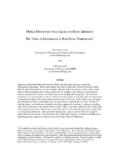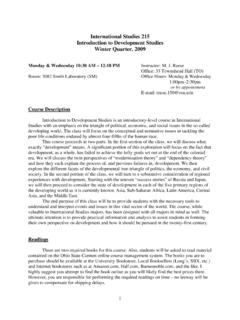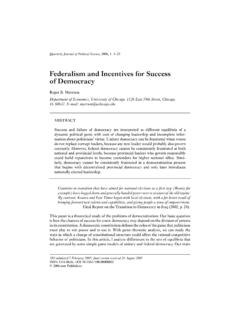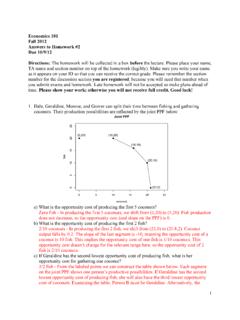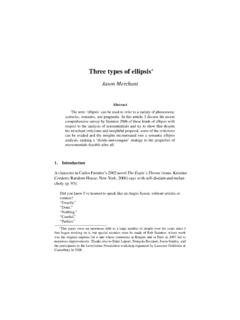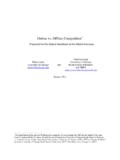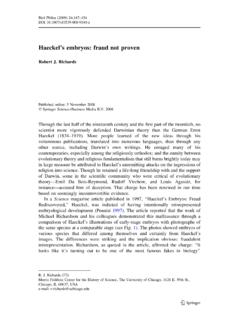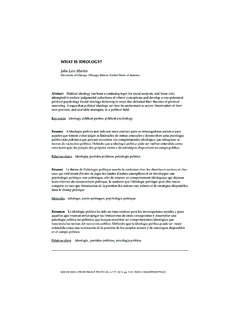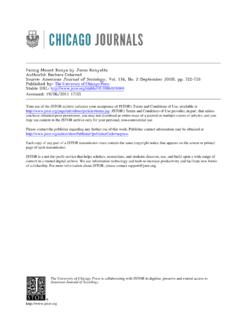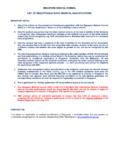Transcription of Moral Judgment and Decision Making - University …
1 17. Moral Judgment and Decision Making Daniel M. Bartels University of Chicago, Booth School of Business, USA. Christopher W. Bauman University of California-Irvine, Paul Merage School of Business, USA. Fiery A. Cushman Harvard University , Department of Psychology, USA. David A. Pizarro Cornell University , Department of Psychology, USA. A. Peter McGraw University of Colorado Boulder, Leeds School of Business, USA. Introduction Moral rules are rigid. The Ten Commandments of the Bible's Old Testament, for example, include unambiguous prohibitions, such as, Thou shalt not kill. Similarly, Kant's categorical imperative is absolute: Act only in accordance with that maxim through which you can at the same time will that it become a universal law (Kant, 1785/2002; emphasis added).
2 In practice, however, people often struggle to determine what is right or wrong. Consider a doctor treating a terminally ill patient who is suffering from unrelenting pain. She may struggle to decide whether the right course of action is to honor the Hippocratic oath (not to mention laws that explicitly forbid euthanasia in most states) or honor the patient's request to provide drugs he can use to end his life, especially if the doctor believes that she would make the same request if she were in the patient's position. She therefore faces a dilemma because multiple Moral principles pro- duce conflicting mandates. Decisions that involve tension between Moral principles can generate cognitive conflict within a person and ignite disagreement between people.
3 Ultimately, small variations in context across situations can tip the balance between competing Moral forces and lead to principle inconsistent decisions. The Wiley Blackwell Handbook of Judgment and Decision Making , First Edition. Edited by Gideon Keren and George Wu. 2015 John Wiley & Sons, Ltd. Published 2015 by John Wiley & Sons, Ltd. Moral Judgment and Decision Making 479. Our focus in this chapter is Moral flexibility, a term that we use that people are strongly motivated to adhere to and affirm their Moral beliefs in their judgments and choices they really want to get it right, they really want to do the right thing but context strongly influences which Moral beliefs are brought to bear in a given situation (cf.)
4 Bartels, 2008). In what follows, we review contemporary research on Moral judg- ment and Decision Making and suggest ways that the major themes in the literature relate to the notion of Moral flexibility. First, we take a step back and explain what makes Moral Judgment and Decision Making unique. We then review three major research themes and their explananda: (a) morally prohibited value trade-offs in Decision Making , (b). rules, reason, and emotion in trade-offs, and (c) judgments of Moral blame and punish- ment. We conclude by commenting on methodological desiderata and presenting understudied areas of inquiry. We acknowledge that this chapter provides an incomplete view of the literature on Moral psychology.
5 We focus on Moral Judgment and Decision Making in situations that involve tension between Moral principles. This focus reflects the intense theoretical curiosity these situations have garnered from behavioral scientists. We do not review one common type of Moral choices people face those that involve tension between Moral principles and (material) self interest because they are (arguably) less perplexing for models of Decision Making than situations where Moral principles are in conflict. Given our focus on Moral Judgment and choice, we also do not review research on (im) Moral behavior ( , stealing, cheating, charitable giving, helping;. for reviews see Tenbrunsel & Smith Crowe, 2008; Trevi o, Weaver, & Reynolds, 2006), research on the correspondence between Moral behaviors (as in Moral licensing; see Merritt, Effron, & Monin, 2010; Sachdeva, Iliev, & Medin, 2009), or research on the correspondence between Moral principles and behavior (as in Moral hypocrisy; see Monin & Merritt, 2012; Tenbrunsel, Diekmann, Wade Benzoni, &.)
6 Bazerman, 2010). Each of these omitted areas of research, as well as others we have not mentioned, illuminate features of morality that are worthy of further review (for broader treatments of morality see edited volumes by Bartels, Bauman, Skitka, &. Medin, 2009; Sinnott Armstrong, 2008a, 2008b, 2008c). Identifying the Moral domain The urge to define is a commendable scientific impulse. Unfortunately, and despite countless attempts, no universally accepted definition of the Moral domain has been offered so far. Rather than toss more fuel onto this bonfire of dispute, we instead gesture at some prototypical features of the Moral domain shared by many approaches. Psychological questions about morality are especially likely to address judgments of justice, rights, and welfare pertaining to how people ought to treat each other.
7 (Turiel, 1983, p. 3). Moral judgments often concern courses of action that entail some harm, e specially loss of life or other physical harm, loss of rightful property, loss of privacy, or other threats to autonomy. Moral judgments also tend to be triggered by actions that affect not only the actor but others as well. People can distinguish doing something that is unwise from doing something that is morally abhorrent, and the assessment that something, if morally relevant, has particular features that we discuss in the next section. 480 Daniel M. Bartels, et al. What makes Moral Judgment and Decision Making unique? Morality has long been treated as a distinct area of scholarship.
8 Should it be? Put differently, why is it necessary to have a separate chapter on Moral Judgment and Decision Making in this handbook? Perhaps morality is distinctive only in its content and not in any deeper structural way. By analogy, one could have a theory of how people buy houses and a theory of how people buy cars, but presumably these theories would differ little in few respects beyond those directly entailed by the content of the good being purchased. However, a theory of how people choose a spouse might be fundamentally different at a structural level from choices about laundry detergent (Goldstein & Weber, 1995; Rettinger & Hastie, 2001). We believe that Moral judgments and choices have some distinctive properties.
9 Several past influential theories of morality simply asserted that the Moral domain was unique based on normative criteria; that is, morality was set apart from other areas of inquiry based on philosophical definitions of what is or is not Moral content ( , Kohlberg, 1976, 1981; Piaget, 1932/1965). But, in a substantial departure from these past theories, a rich body of evidence based on multiple methodologies and differing theoretical orientations now supports the claim that Moral beliefs have distinct psychological properties from nonmoral beliefs ( , Bauman & Skitka, 2009a; Skitka, Bauman, & Sargis, 2005; Smith, 1994; Turiel, 1983). Although the content of Moral beliefs varies across time and place, the belief that there is such a thing as right and wrong seems to be present across widely different cultures (Shweder, Mahapatra, &.)
10 Miller, 1987). The descriptive study of Moral Judgment is essentially the study of what (lay)people think is normative. (We elaborate more on normative approaches in the study of Moral Judgment and Decision Making in the third section under the heading Exercise caution when Making comparisons to normative standards). The domain theory of social Judgment , for example, maintains that people act and reason differently as a function of whether a given situation is governed by Moral rules or social conventions or is subject to personal discretion ( , Nucci, 2001; Turiel, 1983). The personal domain refers to aspects of behavior that are not subject to social rules and thus permits variability in belief and behavior.
